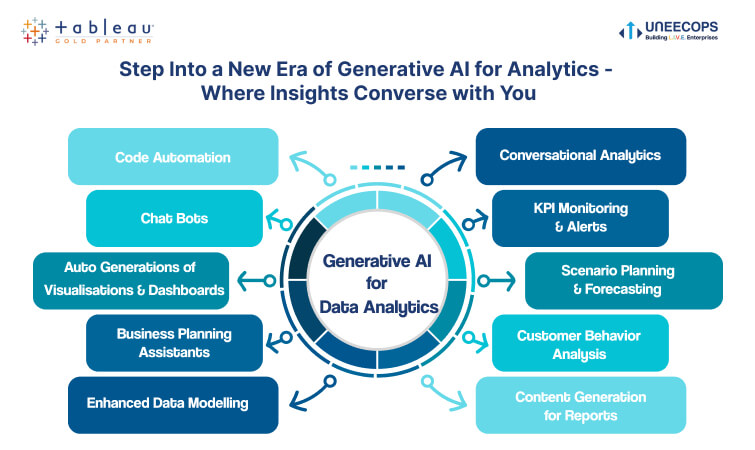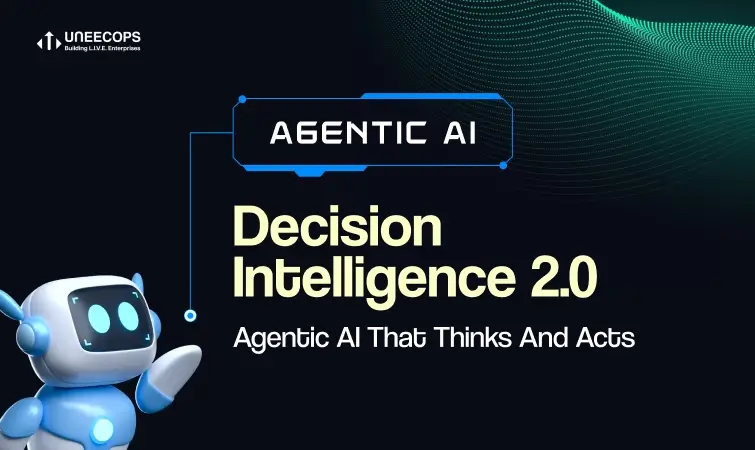If data is a goldmine, AI is now the mining master. How?
Now, you can mine insights, data value and do much more with generative AI for analytics. Yes, AI is not just a writing or research tool anymore. It is much more. Generative AI refers to language models that are used by all professionals – in every profession. They are also data analysts and business leaders’ ultimate assistants. Imagine analytics with real analytical abilities. GenAI for analytics can help organizations amp up their data analytics strategy and scale the value they obtain from their data.
What can generative AI data analytics do? Is it just hype or a true business boon? Let us dig deep on the data goldmining champ:
Step into a New Era of Generative AI for Analytics—where Insights Converse with You
AI is not about theory. It is about its practical applications and wonders a human-like mimic can do. Traditionally, AI could analyze data but with the onset of generative AI for data analytics, much more can be done. The use cases include:
#1 – Code automation: Now, generative AI in data analytics can generate codes for better productivity and speedy delivery.
#2 – Chat bots: Now chat bots enable better customer service and can add a compelling conversational dimension to current dashboards and visualizations.
#3 – Auto-generation of visualizations and dashboards: Generative AI for data visualization can create BI visualizations based on auto-prompts. This can save time in the creation of dashboards and to refine existing visualizations that have grown to be less intuitive over time.
#4 – Business planning assistants: For planners, AI models can help foresee a wide range of future scenarios and generate precise forecasts. This can instill confidence in predictions.
#5 – Enhanced data modeling: AI assists in refining data models, identifying patterns, and structuring datasets, making data preparation faster and more accurate.
#6 – Scenario planning and forecasting: By analyzing historical data, generative AI can simulate various business scenarios and provide predictive insights for better decision-making.
#7 – Conversational analytics: AI-powered chatbots allow users to interact with data conversationally, making analytics accessible to non-technical teams.
#8 – KPI monitoring and alerts: Generative AI can automate the monitoring of key performance indicators, sending real-time alerts when anomalies or trends are detected.
#9 – Content generation for reports: Automatically generate executive summaries, presentations, or detailed analytics reports, saving time and ensuring consistency in communication.
#10 – Customer behavior analysis: Identify customer preferences and trends by analyzing transactional and behavioral data, enabling targeted marketing strategies.
Tech Tools that Infuse GenAI in Data Analytics
Tableau – Tableau Pulse, powered by Tableau GPT and built on the robust foundation of Einstein GPT, revolutionizes the way you interact with data. It enables automated analytics, delivering actionable insights seamlessly through natural language queries and intuitive visualizations. With Tableau Pulse, organizations can effortlessly stay informed, as it proactively surfaces critical insights in real-time, making data-driven decision-making more accessible and efficient than ever before.
SAP – SAP Analytics Cloud now has a jewel on its crown. With Joule, the natural-language AI copilot, SAP now has data analytics + analytical abilities. As a generative AI data analytics assistant, Joule copilot helps businesses plan work and get everything done faster. It understands your business and its language and quickly interprets data for smart insights and better decisions. It is intelligence embedded in your data analytics and can answer questions, perform complex calculations, visualize data, analyze KPI’s, auto-create custom dashboards, make business plans and more.
Microsoft Power BI – Microsoft unveiled Copilot in Power BI, redefining how organizations extract value from data. This groundbreaking feature integrates advanced generative AI for data visualization, enabling users to ask questions or describe desired insights, transforming raw data into actionable reports within moments. Paired with Microsoft Fabric, a unified SaaS platform combining the power of Power BI, Azure Synapse, and Data Factory, this innovation empowers collaboration across data professionals and business users. From seamless data integration to real-time analytics, Fabric simplifies analytics workflows while fostering a robust data-driven culture.
AWS – Amazon introduced Amazon Nova; its intelligent AI assistant. Now, all its applications, like AWS Bedrock, Amazon Q, Amazon SageMaker, AWS App Studio and others come with in-built genAI for analytics. With generative ai for data visualization, users can now use chatbots and virtual assistants, leverage conversational analytics and structure data, summarize data with conversational AI, generate custom code and dashboards as well as harness the power of gen AI for analytics to make significant high-stake business decisions.
Best Practices to Use Generative AI for Analytics
- Be a prompt master and engineer: AI is all about prompts, so it is important the users understand the functions and verbosity necessary to generate optimal results.
- Control your organization’s data strategy: Yes, AI is tremendously helpful – but complete reliance on AI can be a recipe for disaster. Your company’s data strategy cannot depend on a language model, however intelligent it may be. But after you have a strategy in place, you can roll out AI to mine, maintain, structure and understand data. With strong data governance systems, you can even use AI to foresee and predict your business future.
- Leverage workflow and dashboard automation: Generative AI data analytics can create custom dashboards and help with workflow automation but use cases and core processes that can utilize AI are a business leader’s decision.
- Keep data privacy a priority: Ensure that only appropriate data follows proper protocols when feeding into LLMs. Simple steps, like disabling chat history in ChatGPT, and understanding data retention policies in cloud platforms, are essential.
- Continue to enrich your data and supporting metadata: Remember the golden rule: your corporate data’s richness and volume are key to achieving impactful results.
- Familize yourself with your cloud platform: Cloud platforms (AWS, Microsoft, Azure) are in a race to bring accessible LLM to the masses. Today, all data analytics tech tools in the market have generative AI for analytics embedded. So, before you opt for a tool, deep dive into the costs and benefits to your businesses before deploying.
- Leverage Generative AI + BI: LLMs are revolutionizing data access and interpretation. Traditional dashboards may become obsolete as structured prompts enable insights powered by centralized data platforms. Alternatively, BI tools and Generative AI could coexist in hybrid analytics. End users should explore how Generative AI can enhance or transform their BI strategies for the future.
Wrapping up
Thanks to AI tools, you no longer need to create simple dashboards or do the mundane, grass-cutting tasks like data cleansing or statistical analysis. As generative AI in data analytics has brought ease of use to your end-users, Uneecops helps businesses to add AI to their analytics and BI software. With Uneecops AI, you can take your tech platforms to the next level for true digital transformation in 2025. By integrating generative AI capabilities with your analytics and BI tools, we empower organizations to move beyond traditional data strategies and embrace the full potential of AI-powered insights.
Let Uneecops help you mine your data goldmine and pave the way for smarter decisions and unparalleled growth. Begin with a demo!







